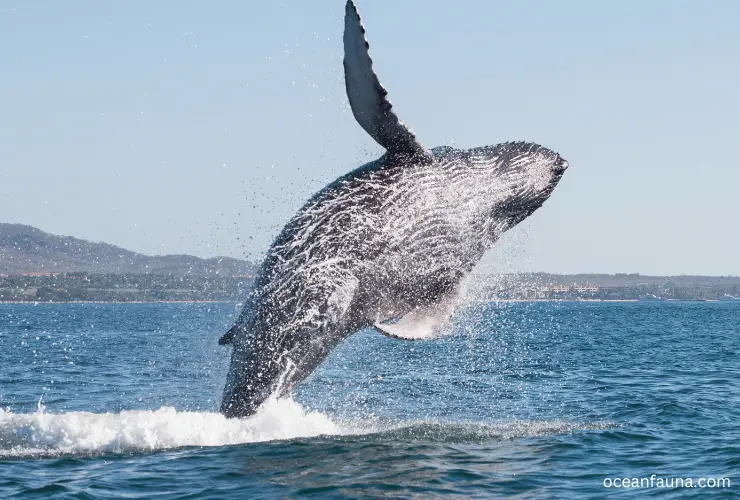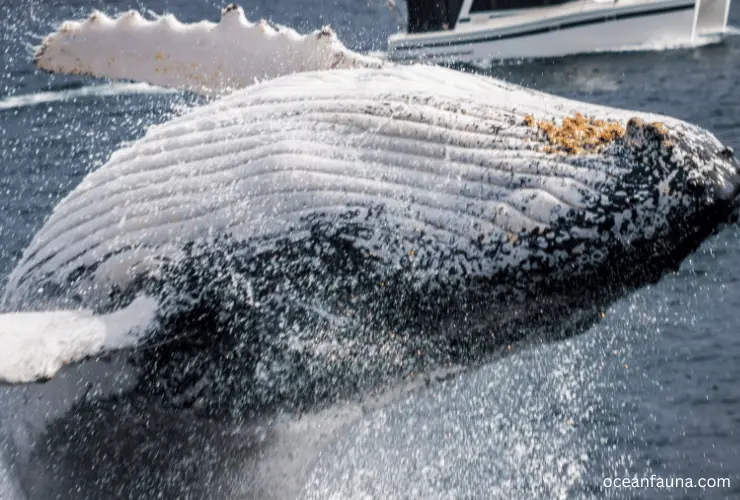Breaching is a behavior seen in many cetaceans, including whales. It is thought that whales breach for various reasons, although there is not much definitive research on the subject.
Some experts believe that breaching may be used as a form of communication between individuals or even to announce their presence to other animals in the area. Others suggest it could be a way to rid themselves of parasites attached to their skin.
It is also thought that whales could use breaching to gain momentum for a deep dive or as an acrobatic display. I will provide an in-depth analysis of why whales breach in this article, including other related details.
What Is Whale Breaching?
Whale breaching is a behavior where the whale propels itself out of the water using its tail and down stroke. It is believed to be done either as part of courtship or mating behavior or to get rid of parasites.

It’s often seen during times when there are large concentrations of prey in one area, which suggests that they may do it to communicate with other whales in the area. When whales breach, they can reach heights of over 30 feet and stay above the water for several seconds before making a spectacular splashdown.
Whale breaching is an impressive sight, and it will surely delight any whale watcher.
Do Whales Need to Breach?
Yes, whales need to breach to communicate and socialize with other whales. It is thought that breaching is used to establish dominance hierarchies among groups of whales and for communication and mating.
Breaching also helps them get rid of parasites or dead skin, which helps keep them healthy. Additionally, breaching is believed to help orient the whale in its environment and has even been observed when the whale appears to be playing.
How Do Whales Breach?
Whales breach by propelling themselves out of the water at high speed and with great force. The whale will typically arch its back and lift its tail out of the water as it breaches, often resulting in the body being completely airborne. Breach heights can range from a few feet to over 30 feet, depending on the size and species of the whale.
The most common type of breaching seen in whales is known as “full breaching,” where a whale will lift most or all of its body above the water’s surface before falling back into the ocean with a large splash.
Many believe that breaching is part of their communication strategy, and whales have been seen to perform this behavior after hearing noises from other whales miles away – potential evidence for long-distance communication between species.
Scientists also hypothesize that breaching may be done for play or even exercise, as it requires immense energy to propel their bodies out of the water.
Other theories suggest that whales use this display as a way to scare away predators, stun prey or possibly even attract mates.
Why Do Whales Breach?
Write in detail about all the reasons under several subheadings>
Communication
Whales use breaching to communicate with other whales, both near and far. It is thought that breaching helps establish dominance hierarchies among whale groups, as well as for communication and mating. Breaching has also been observed when the whale appears to be playing, suggesting that it could be used to socialize.

It is believed that whales could use this behavior to announce their presence to other animals in the area and for long-distance communication between different species of whales.
Health Benefits
Breaching can also help whales rid themselves of parasites or dead skin, which helps keep them healthy. Additionally, breaching helps orientate the whale in its environment and is believed to be a form of exercise as it requires an immense amount of energy to propel their bodies out of the water.
Predation/Prey Avoidance
It is also thought that whales may use breaching to scare away predators, stun prey, or even attract mates. Breaching has been observed when large concentrations of prey are in one area, suggesting that it may be used to herd the prey or signal group members to start hunting.
Breathing
Whales will often perform a shallow breach where they just stick their head out of the water, which is believed to be for breathing purposes. The whale will take in a deep breath when it breaches and then dive back underwater with its mouth open, allowing it to capture more oxygen than if it were just taking breaths at the surface. This type of breathing is known as “deep breathing” and helps whales conserve energy and oxygen when traveling long distances.
Play
It has also been suggested that breaching may be a form of play, as whales often breach when no other whales are around, and it appears to be an enjoyable experience for them. Breaching could also be a way for whales to explore their environment and become familiar with their area.
Mating
Finally, breaching is thought to involve an element of courtship, as males have been observed breaching together synchronously during mating season. This behavior may serve as an impressive display for the females, who will decide which male to mate with.
Why Do Whales Breach So Close to Boats?
One possible explanation as to why whales breach so close to boats is that they are curious. Whales have been observed to be intelligent and inquisitive creatures. When presented with something new, like a boat, they often investigate it closely. This can include breaching the surface of the water as a means to get a better view of the boat from above.

Another explanation is that whales may be using boats for shelter or refuge from predators in their environment. Boats provide an area of calmer waters that offer protection from potential threats. Breaching near boats could also give them a chance to rest and conserve their energy levels.
Finally, whales may breach near boats because their presence helps attract prey for them to feed on. The noise and vibrations created by the boat often help draw prey closer, giving whales a greater opportunity to hunt successfully.
Why Do Whales Slap Tails While Breaching?
Whales slapping their tails while breaching is an interesting behavior that scientists don’t yet fully understand. One possible reason is that it serves as a communication tool between the whales.
Whales are highly social creatures and may use tail slapping to catch the attention of other members of the pod. Breaching also makes loud noises due to the contact with the water, which whales could use to communicate with each other over long distances or between distant pods.
Another probable reason is that tail slapping is used as a form of play behavior, helping whales build bonds and strengthen their social ties. Whales might also use tail slapping to defend against predators in the surrounding environment, scaring them away with loud noises from their tail slapping.
In addition, scientists believe that breaching also helps remove parasites from their skin and improve circulation, which further supports its use as a form of play behavior for young whales who breach more often than adults.
Furthermore, some researchers think that whale tail slaps may also have an acoustic purpose, allowing them to detect changes in water pressure which could help them hunt for food more effectively or avoid predators in dark waters where visibility is limited.
Do Whales Breach for Fun?
Yes, whales do breach for fun. Breaching is a spectacular behavior seen in many cetaceans and involves the whale launching its body vertically out of the water, often making a loud splash. It can appear as if the whale is trying to jump completely out of the water.
There are numerous theories as to why whales breach, including for communication, defence, and courtship purposes, but evidence suggests that breaching may also be done for enjoyment.

Studies have shown that calves breach more often than adults, suggesting that it could be an activity done for play. In fact, one study observed 80 breaches in just one hour by a single calf.
There have also been cases where large groups of dolphins and other aquatic mammals were seen breaching in synchrony with each other, which further supports the theory that they do this partly for fun or joy.
Whales may also breach due to curiosity or stimulation from their environment or surroundings. For instance, humans may feel compelled to investigate or observe certain objects or activities occurring above water when swimming with humans.
When whales breach, they get a different perspective on their surroundings which could explain why they might enjoy doing it so much.
How Often Do Whales Breach?
Whales breach at different frequencies, depending on their species and size. Smaller whales tend to breach more often than larger whales.
For example, humpback whales can breach every 7-15 minutes, whereas sperm whales are known for breaching less frequently, around once every 60-90 minutes.
Generally speaking, baleen whales, such as blue and fin whales, tend to breach less than toothed whales like orcas and dolphins. Breaching is thought to serve many important functions, such as communication among pod members or cleaning parasites off the whale’s skin.
Does It Hurt Whales To Breach?
The spurt of energy required to breach puts a great physical strain on the whale and could cause discomfort or injury. A study by Whitehead1 of humpback and sperm whales found that breaching requires 617 kcal of energy, indicating that it is quite strenuous for the animals.

Furthermore, because breaching often involves leaping out of the water, there is a risk that whales could crash back into the water’s surface or strike other objects like rocks, resulting in possible injury.
However, some experts suggest that whales may breach simply for pleasure or playfulness rather than aggression or any other purpose. This could indicate that breaching does not hurt them but instead provides a sense of satisfaction.
For example, researchers have observed humpback whales repeatedly breaching in areas with no food sources, suggesting they were doing it out of enjoyment rather than necessity.
In addition, some speculate that breaching can help keep whales cool during hot weather and remove parasites from their skin3, providing a health benefit.
How Long Can Whales Go Without Breaching?
Whales can go for extended periods without breaching the surface of the water.
Depending on the species, most whales can stay submerged for up to 90 minutes before returning for air. Cuvier’s beaked whales have demonstrated an even greater capacity, with their longest recorded dive lasting 222 minutes.
Additionally, some species have been observed diving as deep as 1.8 miles below the ocean’s surface and staying underwater for up to two hours or more. This remarkable feat is made possible due to a range of physiological adaptations that allow them to conserve oxygen and store it in their bodies and slow down their metabolism while diving and conserving energy.
On average, whales will take 3-5 breaths per minute at the surface and then slow this breathing rate significantly while submerging to save oxygen. In addition, they can reduce blood flow through their muscles while diving, which helps conserve oxygen even further.
These adaptations enable them to remain underwater for extended periods without coming back up and breaching the surface to breathe.
Conclusion
That’s all about whales breaching. Now you know almost everything about why whales breach. Breaching serves important functions such as communication among members of a pod or cleaning parasites off the skin, and it may also pleasure the whales.
If you have any further queries regarding the breaching of whales, let me know.


Was helpful for my assignment
Thank you.